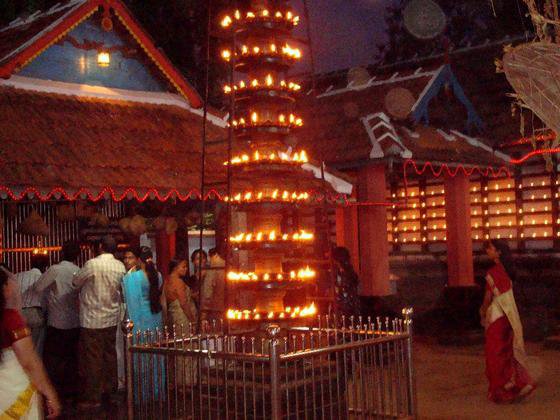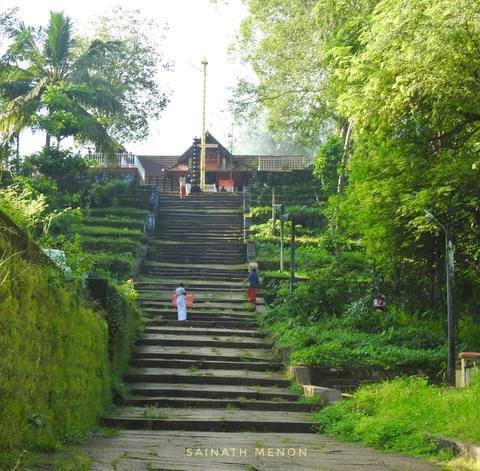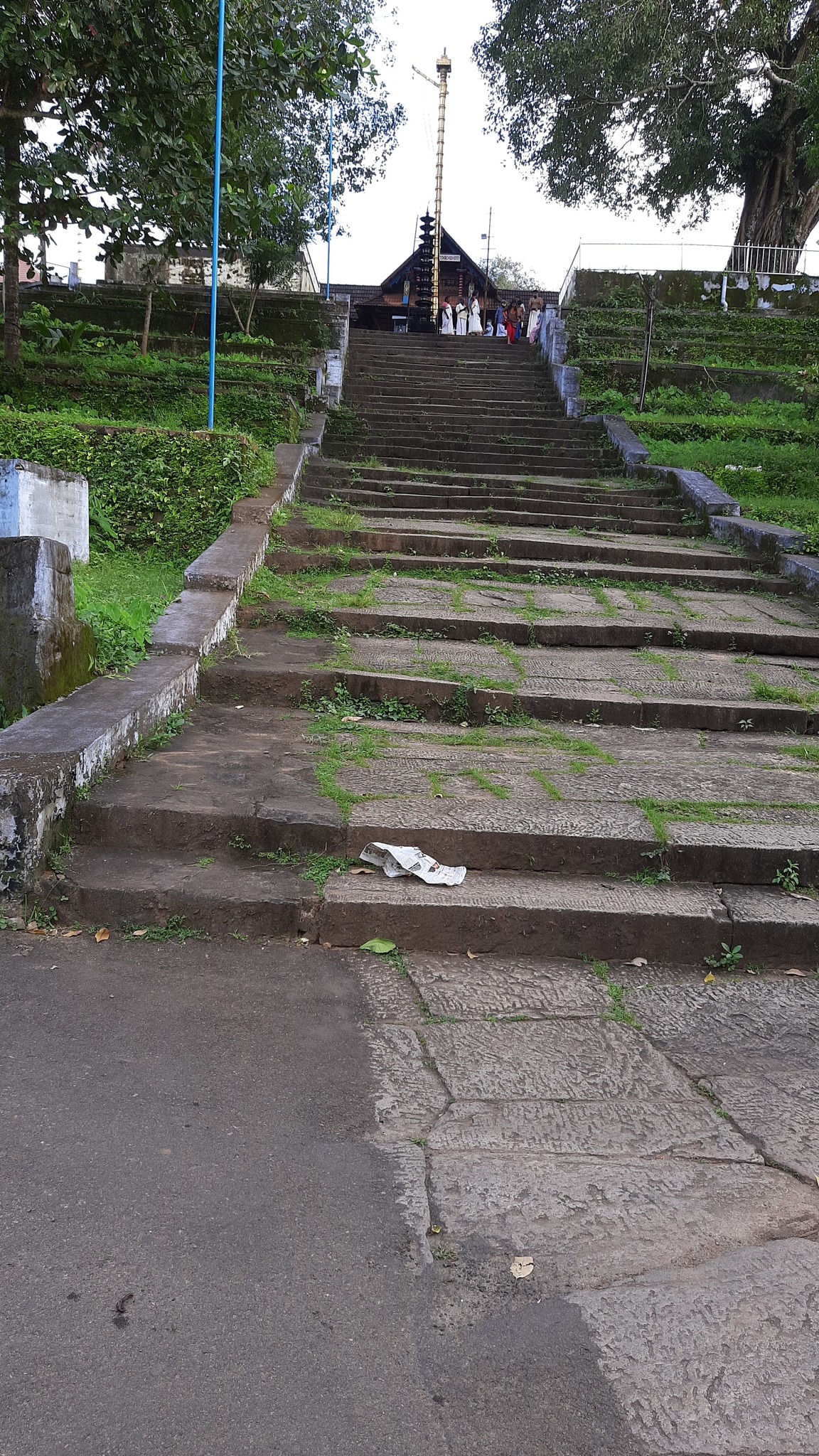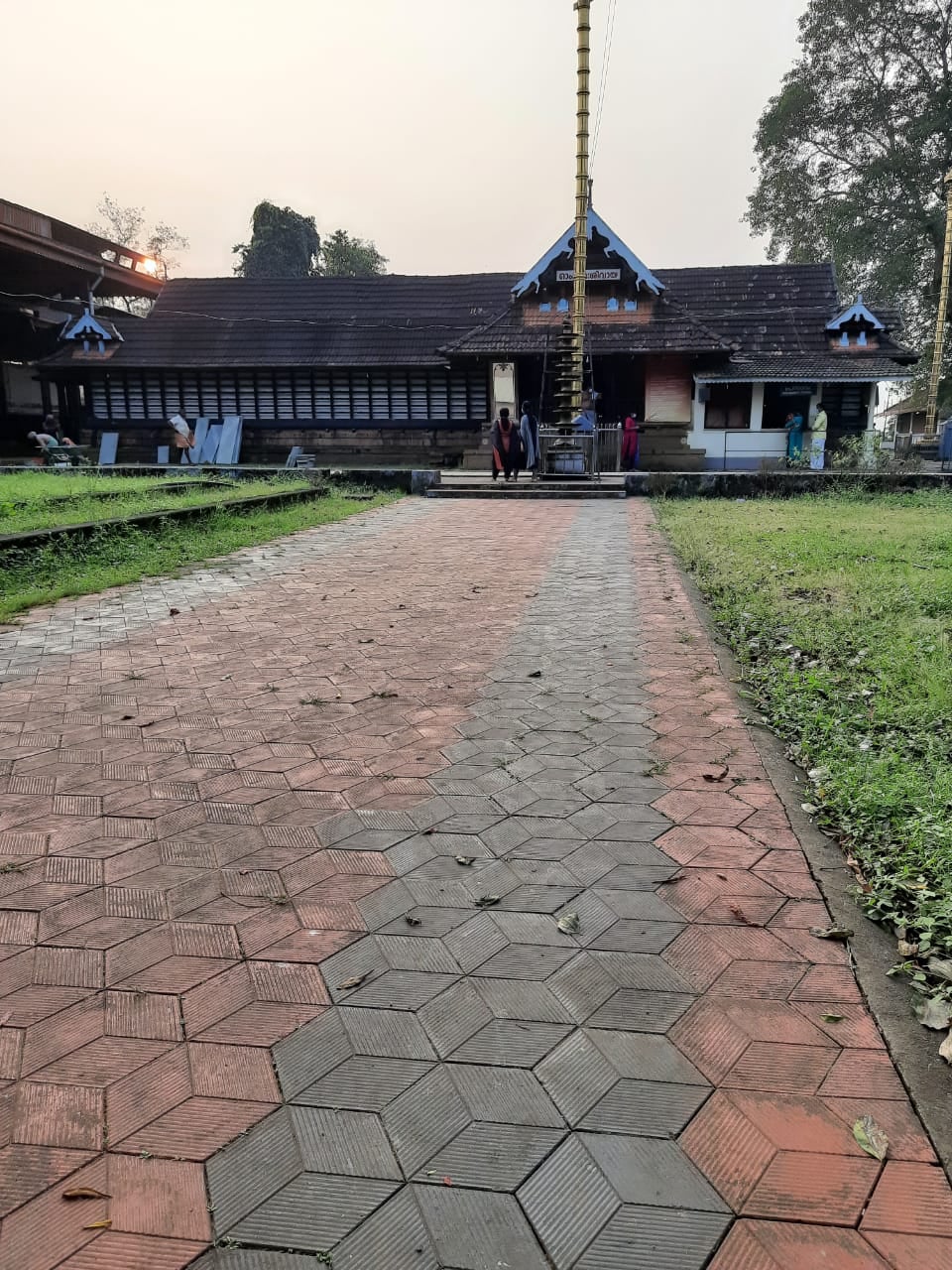Thirumandhamkunnu Temple is a historically significant Hindu temple located in Angadipuram, which was once the capital of the Valluvanad royal family, in the Malappuram district of Kerala.
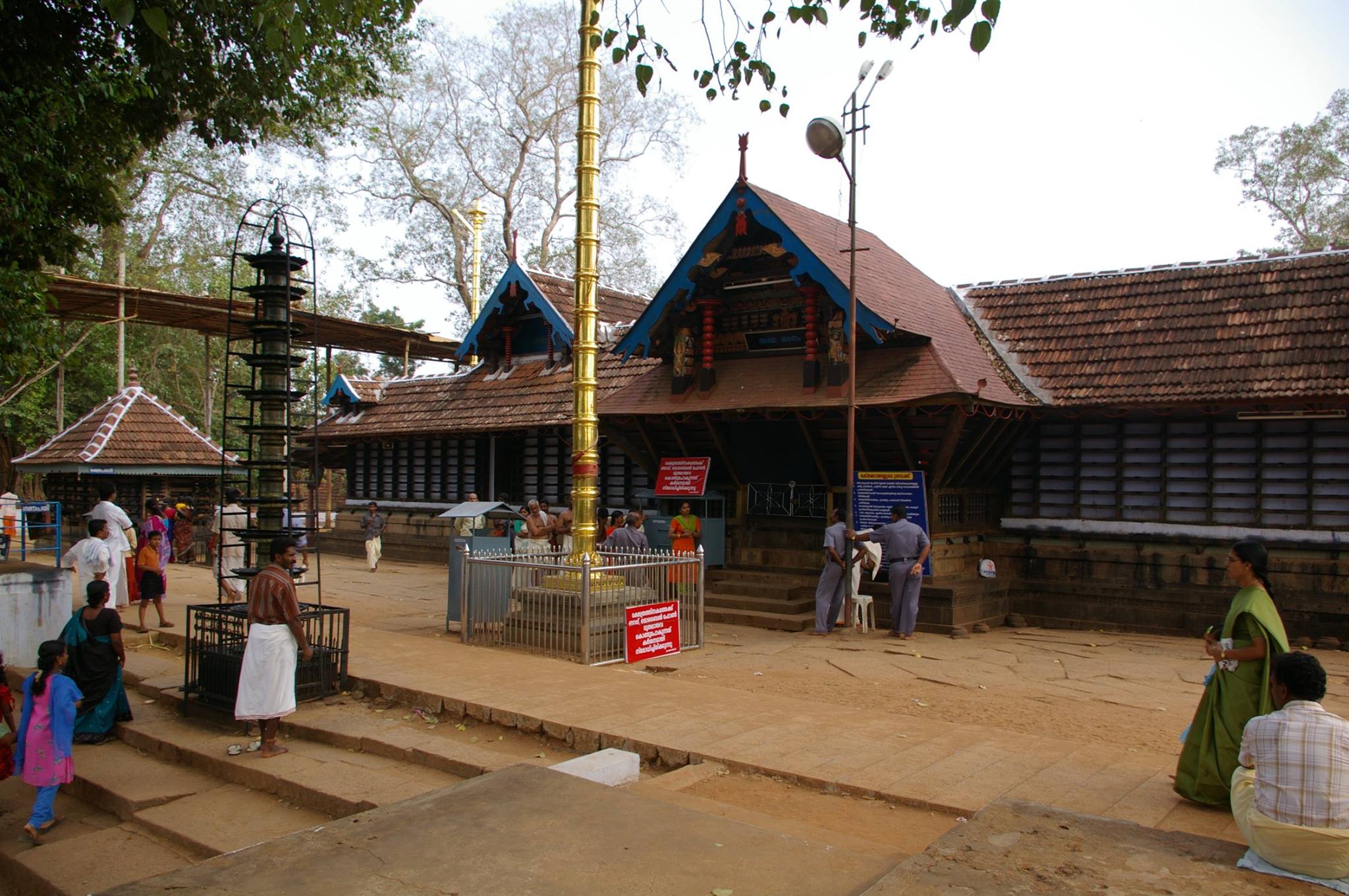
The presiding deity, Thirumandhamkunnilamma (a form of Goddess Bhadrakali or Parvati), was the paradevatha (royal goddess) of the Valluvanad kings who ruled the region during the medieval period.
Nair warriors known as Chavers (literally meaning "martyrs") used to set out from this temple to participate in the famed Mamankam festival held at Thirunavaya. A commemorative structure called Chaver Thara still stands in front of the temple’s main entrance, honoring their memory.
Though the principal deity is Lord Shiva, the temple is more popularly associated with Goddess Bhadrakali, known locally as Thirumandhamkunnilamma, and also worships Lord Ganesha. One of the most significant rituals performed here is the Mangalya Puja, believed to remove obstacles to marriage. The goddess is revered as the Supreme Mother, Shakti Devi. Bhadrakali, who is said to have emerged from Lord Shiva’s third eye to vanquish the demon Daruka, is worshipped for prosperity, protection, and spiritual liberation.
Important offerings at the temple include Mangalya Puja, Rigveda Laksharchana, Chandattam, and Kalampattu. The temple is also known for its unique rituals not commonly seen elsewhere, and its hilltop location offers a scenic view of the surrounding countryside. The annual eleven-day festival held in March–April draws thousands of devotees and is one of the most important events at the temple. According to legend, King Mandhata of the Surya dynasty, after ruling his kingdom for many years, renounced worldly life and handed over his throne to his successors. He chose instead to devote himself to deep meditation on Lord Shiva, aspiring to attain the divine presence of the supreme god.
Pleased by the king's intense penance, Lord Shiva appeared before him at Mount Kailash and offered to grant him any boon. King Mandhata humbly requested an idol of Lord Shiva that he could worship for the rest of his life.
Moved by his devotion, Lord Shiva gifted him a sacred Shiva Lingam — the very one that Goddess Parvati herself used to worship. After handing over the holy Lingam, Lord Shiva vanished. With deep reverence, King Mandhata carried the Shiva Lingam on his head and began his journey down from Mount Kailash, eventually reaching a serene hill in present-day Kerala, now known as Thirumandhamkunnu.
The hill was enchanting — a crystal-clear spring flowed down its northern slope, the forest echoed with the songs of birds, and even wild animals like lions, tigers, and elephants lived in peaceful harmony. The region was lush with fragrant trees and plants, creating an atmosphere of divine tranquility. Deeply moved by the beauty and serenity of the place, the king, feeling the Shiva Lingam growing heavy on his head, gently placed it on the ground. Instantly, the Lingam became rooted to the spot, establishing itself there permanently — marking the sacred origin of the Thirumandhamkunnu Temple.
According to the legend, Lord Shiva gifted the sacred Shiva Lingam to King Mandhata while his consort, Goddess Parvati, was away for her bath. When Parvati returned and went to worship the Lingam, she was distressed to find it missing. Upon inquiry, she learned that Lord Shiva had given it to King Mandhata. Deeply attached to the Lingam, Parvati demanded its return. Shiva, though unwilling to take it back himself, told her she was free to retrieve it if she could.
Determined, Parvati sent Goddess Bhadrakali along with an army of bhoothas (spiritual attendants) to reclaim the Lingam. Bhadrakali and her forces approached the northern slope of the Thirumandhamkunnu hill where the Lingam had been installed by the king. However, the divine brilliance radiating from the Shiva Lingam was so intense that it blinded them, preventing them from advancing uphill.
Unable to move forward, they began hurling weapons from the base of the hill toward the king and his attendants.
The ascetics who served King Mandhata were unarmed and had no proper weapons to defend themselves. In desperation, they plucked Attanga nuts (a type of medicinal fruit) from nearby creepers and threw them at the attackers. Miraculously, through the power of Lord Shiva and the spiritual strength of King Mandhata, the nuts transformed into powerful arrows. Overwhelmed, Bhadrakali and her army could not withstand the divine resistance, and the battle continued for fifteen days.
This epic encounter is commemorated annually in the temple through the ritual of Attangayeru — the symbolic throwing of Attanga nuts — held on the first day of the Malayalam month Thulam (around mid-October), on the new moon day, just before the Pantheerady Pooja. This custom serves as a living memory of the legendary battle between King Mandhata and Goddess Bhadrakali. As the battle raged on and defeat seemed imminent, Mahamaya (Goddess Bhadrakali) assumed her terrifying Vishwaroopa form, wearing an elephant and a lion as earrings, which caused the ascetics to faint in fear. When she reached the hilltop, King Mandhata, unable to resist her power, embraced the Shiva Lingam to protect it.
In the ensuing struggle, the Lingam split into two, and from the divine light (Jyothis) that burst forth, the Trimurthis—Brahma, Vishnu, and Shiva—along with Goddess Parvati appeared. Parvati, acknowledging her deep attachment to the Lingam, told Mandhata that although it was dear to her, she would not take it back against Shiva’s will. Instead, she chose to merge into the Lingam and remain there forever. She also instructed that her daughter Kali, who was not different from her and had arrived first, should be consecrated facing north and honored with all rituals and festivals. Parvati then disappeared into the Lingam, marking the spot as the Sreemoolasthanam.
Shiva Lingam, still in its split form, lies beneath the pedestal and Prabhamandalam, and can be seen only during the early morning abhishekam and Malarnivedyam rituals, symbolizing the eternal presence of Parvati and the divine events that sanctified Thirumandhamkunnu Temple. As ordained by Goddess Parvathy, Bhadrakali along with the Sapthamathrukkal (Seven Mother Goddesses), Veerabhadra, and Ganapathy was installed facing north in a sanctum known as "Mathrusala", where Pooram, Pattu, and other rituals dedicated to this divine form are celebrated. When Parvathy manifested at Thirumandhamkunnu, infant Ganapathy was also present and was subsequently installed at the Sreemoolasthanam.
While Parvathy appeared facing west, the Sivalinga at Sreemoolasthanam was oriented eastward, necessitating two darshan openings—one on the east and another on the west. The royal family of Valluva Konathiri traditionally kept the western door closed except during darshan, but in recent times, these restrictions have been eased and the door is now kept open briefly after each pooja for devotees. King Mandhatha spent many years in deep meditation at Thirumandhamkunnu and, sensing his time on earth was nearing its end, entrusted the temple to two Brahmins, handing over a sacred text detailing the pooja rituals.
He then withdrew to the nearby forest, now known as "Kukshipparakkad", where he left his mortal body through yogic powers. Devotees who circumambulate this sacred grove still pick leaves with reverence and wear them in their hair as a mark of devotion. The area remains a protected forest. A Devaprashnam (astrological consultation) conducted in 1959 revealed that an idol of Mandhatha should be installed there, with regular poojas performed. Priests still offer a special pooja to Mandhatha on the Chithra day in the month of Midhunam, which holds great significance.
Two Brahmins were entrusted with the upkeep of the Thirumandhamkunnu Temple—one who cleared the jungle around the idol came to be known as “Kattillamuttam,” and the other, who prepared the pavilion for the prathishta (consecration), became known as “Panthalakode”. Thanthri (chief priest) of the temple continues to descend from one of these families. A Nair Karyasthan who assisted them was honored with the title “Chathathumarar” and was given the sacred duty of blowing the holy conch. Upon being informed by the Namboodiris, the Vadakkara Swaroopam Raja, a subordinate of the Valluvanadu Raja and holder of the title Mannarmala Raja, rushed to the temple. Seeing the overlord of the hill, the goddess rose and paid homage to him—this divine humility from Devi, the sustainer of the three worlds, overwhelmed the Raja, who in return prayed to be accepted as her son.
He presented an elephant to the goddess and began worshipping her from its rear, standing in its shadow—a custom still followed by his descendants, who do not take direct darshan of Thirumandhamkunnu Bhagavathy. The first Valluva Raja to assume control of the temple delegated its management to the local feudal lords, the Ettuveetil Achans, and appointed the Erukalikara Nair as the Kavudaya Nair. The Sreemoolasthanam, still without a roof, indicates its origin as a sacred grove (kavu).
Wall paintings in the Mathrusala depict these legends, and these artworks—comparable in style to those found in Suchindram, Pundarikkapuram, Vaikom, and Guruvayur—were completed in 1944. The grand annual festival of the temple, Thirumandhamkunnu Pooram, spans eleven days and is a major celebration in Malappuram district. A highlight is the Aarattu, the ceremonial bath of the deity, during which the idol is carried atop the tallest elephant, accompanied by five others, in a grand procession to a nearby lake where the goddess is ritually bathed before being returned to the sanctum.
അങ്ങാടിപ്പുറം തിരുമാന്ധാംകുന്ന് ഭഗവതി ക്ഷേത്രം
മലപ്പുറം ജില്ലയിലെ പെരിന്തൽമണ്ണയ്ക്ക് സമീപം സ്ഥിതിചെയ്യുന്ന അങ്ങാടിപ്പുറം എന്ന സ്ഥലത്താണ് ആലങ്കാരികമായി പുച്ഛിക്കപ്പെടുന്ന തിരുമാന്ധാംകുന്ന് ശ്രീ ഭഗവതി ക്ഷേത്രം സ്ഥിതിചെയ്യുന്നത്. അതിപുരാതനതയും അതിശയകരമായ ദൈവികമഹത്വവുമാണ് ഈ ക്ഷേത്രത്തിന്റേത്. വള്ളുവക്കോനാതിരിമാരുടെ കുലദൈവമായ, സാക്ഷാൽ ആദിപരാശക്തിയായ ശ്രീ ഭദ്രകാളിയാണ് പ്രധാന പ്രതിഷ്ഠ. സമപ്രാധാന്യത്തോടെ ഇവിടെ ശ്രീപരമേശ്വരനും സ്ഥിതിചെയ്യുന്നു.
വലിയതും മനോഹരവുമായ ശിവലിംഗപ്രതിഷ്ഠ ഈ ക്ഷേത്രത്തിന്റെ പ്രധാന ആകർഷണങ്ങളിലൊന്നാണ്. എന്നിരുന്നാലും, ‘തിരുമാന്ധാംകുന്നിലമ്മ’ എന്നപേരിൽ അറിയപ്പെടുന്ന ഭഗവതിയെയാണ് കൂടുതൽ ഭക്തരാൽ ആരാധിക്കപ്പെടുന്നത്.
ശിവനും ശക്തിയും ഒന്നായി ആരാധിക്കപ്പെടുന്ന ശിവശക്തി ഭാവമുള്ള ക്ഷേത്രമാണിതെന്ന് പറയാം. ഭദ്രകാളിയായ ഭഗവതിയാണ് മുഖ്യപ്രതിഷ്ഠയായിട്ടുള്ളത് എങ്കിലും, മഹാലക്ഷ്മിയും മഹാസരസ്വതിയും ഉള്പ്പെടെയുള്ള ആദിപരാശക്തിയുടെ മറ്റു മുഖഭാവങ്ങളിലും ഭഗവതിയെ ഇവിടെ ആരാധിക്കുന്നു.
ഭഗവതിയുടെ ശ്രീകോവിലിനുള്ളിലാണ് സപ്തമാതാക്കളുടെ പ്രതിഷ്ഠയും സ്ഥിതിചെയ്യുന്നത്. ബ്രാഹ്മി, വൈഷ്ണവി, മഹേശ്വരി, ഇന്ദ്രാണി, വാരാഹി, ചാമുണ്ഡി എന്നിവ ഉൾപ്പെടെയുള്ള ഏഴ് മാതാക്കളാണ് ഇവർ. വിഘ്നേശ്വരനായ ശ്രീഗണപതിയുമുണ്ട്, ഉപദേവനായി ഭക്തിപൂർവ്വം ആരാധിക്കപ്പെടുന്നത്. ക്ഷേത്രത്തിലെ പ്രസിദ്ധമായ മംഗല്യപൂജ ഗണപതിയുടെ സന്നിധിയിലാണ് ആചരിക്കപ്പെടുന്നത്.കേരളത്തിലെ ഏറ്റവും വലിയ ഭദ്രകാളി പ്രതിഷ്ഠകളിൽ ഒന്നായിരിക്കുന്നു തിരുമാന്ധാംകുന്ന് ക്ഷേത്രം.
മംഗല്യസിദ്ധിക്കും ദുരിതമോചനത്തിനുമായി ഭക്തജനങ്ങൾ ആശ്രയിക്കുന്ന പ്രസിദ്ധ തീർത്ഥാടനകേന്ദ്രം കൂടിയാണിത്. വള്ളുവനാട് രാജാക്കന്മാരാണ് ഈ ക്ഷേത്രം സംരക്ഷിച്ച് നയിച്ചിരുന്നത്. പരശുരാമൻ സ്ഥാപിച്ചുവെന്ന് വിശ്വസിക്കപ്പെടുന്ന 108 ശിവക്ഷേത്രങ്ങളിൽ ഒന്നായ ശിവക്ഷേത്രവുമാണ് തിരുമാന്ധാംകുന്ന്.
കേരളത്തിലെ ഭദ്രകാളി ക്ഷേത്രങ്ങളിൽ പ്രാധാന്യമുള്ള മൂന്ന് മഹാക്ഷേത്രങ്ങളിൽ ഒന്നാണ് ഇത്. മലബാറിൽ തിരുമാന്ധാംകുന്ന്, കൊച്ചിയിൽ കൊടുങ്ങല്ലൂർ, തിരുവിതാംകൂറിൽ പരുമല പനയന്നാർകാവ് – ഈ മൂന്ന് ക്ഷേത്രങ്ങളും തുല്യമെന്ന നിലയിൽ ഭക്തർക്ക് വിശ്വാസപൂർവമായ ആരാധനാലയങ്ങളാണ്.
ഈ മൂന്ന് ക്ഷേത്രങ്ങളിലും ഭദ്രകാളിക്ക് വടക്കോട്ട് ദർശനമാണ്. ഇതിലൊന്നിലും ശിവസാന്നിധ്യം ഉണ്ടെന്നും ഇവ ചുരുങ്ങിയില്ലാതെ 108 ശിവക്ഷേത്രങ്ങളിൽ ഉൾപ്പെടുന്നതുമാണ് മറ്റൊരു പ്രധാന പ്രത്യേകത. മൂവറ്റത്തുമുള്ള പ്രതിമകൾ ദാരുവിഗ്രഹങ്ങളാണ് (മരത്തിൽ നിർമ്മിച്ച വിഗ്രഹം).
മലബാർ ദേവസ്വം ബോർഡിന്റെ കീഴിലാണു തിരുമാന്ധാംകുന്ന് ക്ഷേത്രം പ്രവർത്തിക്കുന്നത്. ചൊവ്വയും വെള്ളിയുമായി കൂടെ, പൗർണ്ണമി, അമാവാസി, നവരാത്രി, തൃക്കാർത്തിക, ശിവരാത്രി, തിരുവാതിര തുടങ്ങിയ തിരുനാൾ ദിനങ്ങളിലും, ഓരോ മലയാളം–ഇംഗ്ലീഷ് മാസങ്ങളിലെ ആദ്യ തീയതികളിലും ദർശനത്തിന് പ്രത്യേക പ്രാധാന്യമുണ്ട്.
ഇവിടത്തെ ഭഗവതിയെ സ്തുതിച്ചു കൊണ്ട് മഹാകവി പൂന്താനം രചിച്ച പ്രശസ്ത കൃതിയാണ് "ഘനസംഘം", അത് ഭക്തജനങ്ങളിൽ ഏറെ അംഗീകാരം നേടിയിട്ടുള്ളതുമാണ്. തിരുമാന്ധാംകുന്ന് ക്ഷേത്രത്തിലെ പ്രധാന വാർഷികാഘോഷം പൂരമാണ്. മാമാങ്കത്തിൽ ചുരികത്തലപ്പുകൾകൊണ്ട് കണക്കുകൾ തീർക്കാനിറങ്ങിയ ചാവേറുകളുടെ വീരസ്മരണകൾ തിരുമാന്ധാംകുന്ന് പൂരത്തെ കേരളചരിത്രത്തിന്റെ ഭാഗമാക്കുന്നു. വള്ളുവക്കോനാതിരിമാർ അവരുടെ കുലദൈവമായ ഭദ്രകാളിയെ പുരാതനകാലം മുതൽ ആരാധിക്കുകയും ആഘോഷിക്കുകയും ചെയ്തിരുന്നു.
എന്നാൽ, നേരെ പറയുമ്പോൾ, പണ്ട് പെരുമാക്കന്മാർ ആഘോഷിച്ചിരുന്ന മാമാങ്കം, പിന്നീട് കാലക്രമേണ വെള്ളാട്ടിരി ആശ്രയമായി.
എന്നാൽ, സാമൂതിരിയുടെ വരവോടെ പടയോട്ടം മാറ്റി, കാര്യങ്ങൾ മാറ്റിമറിഞ്ഞു. അടിസ്ഥാനം നിലനിര്ത്തുന്നതിനുള്ള വെള്ളാട്ടിരിയുടെ അശാസ്ത്രീയമായ നടപടി, സാമൂതിരിയുടെ ശക്തി മുന്നോട്ട് പോയതോടെ തോൽവി മുഖ്യമായിരുന്നുവെന്ന് പറയാം. തുടര്ന്നുള്ള കാലത്ത്, മാമാങ്കം രാഷ്ട്രീയമായും സാമൂഹികമായും വിഘടിച്ചു പോയി, എന്നാൽ പരിണാമത്തിലേക്ക് പുതിയ തിരുമാന്ധാംകുന്ന് പൂർക്ക് തുടക്കമാക്കി.
മാമാങ്കം നഷ്ടപ്പെട്ടപ്പോഴാണ് വലിയ ഉത്സവത്തിന്, അത്രേ തിരുമാന്ധാംകുന്ന് പൂരം പ്രതിസന്ധി പരിഹരിക്കാൻ സഹായിച്ചു. 12 വർഷത്തിലൊരിക്കലായിരുന്നു ആദ്യകാലത്ത് തിരുമാന്ധാംകുന്ന് പൂർ പ്രചാരത്തിലുള്ളത്. എന്നാൽ, കൊല്ലവർഷം 1058-ൽ വള്ളുവക്കോനാതിരി, മങ്കട കോവിലകത്ത് നിന്നുമുള്ള പൂരം തുടക്കമായി, കൂടാതെ ഈ ആഘോഷം ഇന്ന് എല്ലാ വർഷവും നടത്തപ്പെടുന്നു. തിരുമാന്ധാംകുന്ന് ക്ഷേത്രം, പേരു സൂചിപ്പിക്കുന്നതുപോലെ, ഒരു ചെറിയ കുന്നിന്റെ മുകളിലാണ് സ്ഥിതിചെയ്യുന്നത്. ക്ഷേത്രത്തിന് നാല് ദിശകളിലുമുള്ള കവാടങ്ങളാണ്. വടക്കേ നടയിൽ, ഇറക്കത്തിൽ, കടലുണ്ടിപ്പുഴയുടെ പോഷകനദി കടന്നുപോകുന്നു. ഉത്സവക്കാലത്ത്, ഈ പുഴയ്ക്കപ്പുറം പാലം കൂടിയുള്ള വഴിയിലാണ് ഭഗവതിയുടെ ആറാട്ട് നടക്കുന്നത്.
ഒരു കിലോമീറ്റർ അകലെ, പാലത്തിനപ്പുറം, ഇടത്തുപുറം പൂന്താനം ശ്രീകൃഷ്ണസ്വാമി ക്ഷേത്രം സ്ഥിതിചെയ്യുന്നു. ഈ ക്ഷേത്രത്തിന്റെ പ്രതിഷ്ഠയും ഭക്തകവിയായിരുന്ന പൂന്താനം നമ്പൂതിരിയുടെ നേതൃത്വത്തിലാണ്. പുരാതനകാലം മുതൽ അദ്ദേഹം നയിച്ച പ്രതിഷ്ഠ, ശ്രീകൃഷ്ണന്റെ ദർശനമായാണ് പ്രസിദ്ധം.
തിരുമാന്ധാംകുന്നിൽ ദർശനത്തിനെത്തുന്ന ഭക്തർ ഈ ക്ഷേത്രത്തിലും ഭഗവാന്റെ ദർശനത്തിനായി പോകാറുണ്ട്. ക്ഷേത്രത്തിലെ നാലമ്പലത്തിൽ, വടക്കോട്ട്, ഭദ്രകാളിയുടെ ദർശനം ലഭിക്കും, അതിനടുത്തുള്ള കിഴക്കോട്ടു, ശിവന്റെ ശ്രീകോവിലിന്റെ ദർശനവും കാണാം. തെക്കുഭാഗത്ത്, കിഴക്കോട്ടായി, പിളർന്ന രീതിയിൽ ഒരു ശിവലിംഗം കാണപ്പെടുന്നു, ഈ സ്ഥലം "ശ്രീമൂലസ്ഥാനമ" എന്നറിയപ്പെടുന്നു.
ഇതിന്റെ ഐതിഹ്യപ്രകാരമാണ് മാന്ധാതാവും ഭദ്രകാളിയും തമ്മിൽ നടത്തിയ ഏറ്റുമുട്ടലിൽ ഈ ശിവലിംഗം പിളർന്നു പോയതെന്ന് പറയപ്പെടുന്നു.
ക്ഷേത്രത്തിലെ രണ്ടുവശത്തും കൊടിമരങ്ങൾ സ്ഥിതിചെയ്യുന്നു. പ്രതിഷ്ഠകളായ ഗണപതി, നാഗന്മാർ തുടങ്ങിയ ഉപദേവതകളെക്കുറിച്ചുള്ള ആൽത്തറയും ഇവിടെ സ്ഥിതിചെയ്യുന്നു. കേരളത്തിലെ ഏറ്റവും വലിയ ഭഗവതിപ്രതിഷ്ഠയാണ് തിരുമാന്ധാംകുന്ന് ക്ഷേത്രത്തിൽ ഉള്ളത്. വടക്കേ കൊടിമരത്തിനടുത്തുള്ള ബലിക്കൽപുരയിലൂടെ കയറി, നാലമ്പലത്തിൽ എത്താം. ഇവിടെ, മാതൃത്സാല എന്ന ശ്രീകോവിലിലാണ് തിരുമാന്ധാംകുന്നിലമ്മയുടെ പ്രതിഷ്ഠ.
ആദിപരാശക്തിയായ ഭദ്രകാളി, സപ്തമാതാക്കളോടുകൂടി ഈ ക്ഷേത്രത്തിൽ വിരാജിക്കുന്നു. നാലടിയോളം ഉയരമുള്ള ദാരുവിഗ്രഹമാണ് മാതൃത്സാലയിൽ പ്രതിഷ്ഠിയ്ക്കപ്പെട്ടിരിക്കുന്നത്.
വടക്കോട്ടുള്ള ദർശനത്തിൽ, ഭഗവതിയുടെ ദാരുവിഗ്രഹം ഇടതുകാൽ മടക്കി വെച്ച് വലതുകാൽ താഴോട്ടു തൂക്കിയിട്ടുള്ള രൂപത്തിൽ കാണപ്പെടുന്നു. എട്ടു കൈകളുള്ള ഭഗവതിയുടെ കൈകളിൽ ശൂലം, സർപ്പം, വാൾ, പരിച തുടങ്ങിയ ആയുധങ്ങൾ, കൂടാതെ ദാരികന്റെ ശിരസ്സും പിടിച്ചിരിക്കുന്നു.
ഇങ്ങനെ രൂപഭാവങ്ങളിൽ ഭദ്രകാളിയെന്ന വിശേഷതയ്ക്കൊപ്പം, ദുർഗ്ഗ, മഹാലക്ഷ്മി, മഹാസരസ്വതി തുടങ്ങിയ ഭാവങ്ങളിലും തിരുമാന്ധാംകുന്നിലമ്മ ആരാധിക്കപ്പെടുന്നു.
കൊടുങ്ങല്ലൂരിലെ പ്രതിഷ്ഠയേക്കാൾ ഉയരം കൂടിയാണിത്, കൂടാതെ കൊടുങ്ങല്ലൂരിലേതുപോലെ രുരുജിത സമ്പ്രദായത്തിലാണ് ഇവിടെ പ്രതിഷ്ഠിച്ചിരുന്നത്. ഈ സമ്പ്രദായം കശ്മീരിൽ ഉദ്ഭവിച്ചതും പിന്നീട് കേരളത്തിലേക്ക് കൊണ്ടുവരപ്പെട്ടതുമാണ്.
കിഴക്കോട്ടോ പടിഞ്ഞാറോട്ടോ ദർശനത്തിൽ ശിവനും, വടക്കോട്ടുള്ള ദർശനത്തിൽ സപ്തമാതൃക്കളോടുകൂടി ഭദ്രകാളിയും, ശിവഭൂതമായ ക്ഷേത്രപാലനും അടങ്ങുന്നതാണ് ഈ സങ്കല്പം.
ബഹുബേരസമ്പ്രദായത്തിൽ (ഒന്നിലധികം വിഗ്രഹങ്ങൾ ഒരുമിച്ച് പൂജിയ്ക്കുന്ന സമ്പ്രദായം) പൂജകൾ നടത്തുന്ന ക്ഷേത്രമാണിത്. മൂലവിഗ്രഹത്തോടൊപ്പം രണ്ട് ശ്രീചക്രങ്ങൾ കൂടി പ്രാധാന്യം നേടിയിരിക്കുന്നു.
ആദിപരാശക്തിയായ മഹാത്രിപുരസുന്ദരിയെയാണ് ഈ ശ്രീചക്രങ്ങളിൽ ആരാധിയ്ക്കുന്നത്.
ദാരുവിഗ്രഹമായതിനാൽ, വിഗ്രഹത്തിന് അഭിഷേകങ്ങൾ നടത്താറില്ല. പകരം, പ്രത്യേക വിഗ്രഹം പ്രതിഷ്ഠിയ്ക്കപ്പെട്ടിട്ടുണ്ട്.
കർക്കടകമാസത്തിൽ, എല്ലാ വർഷവും നടത്തുന്ന ചാന്താട്ടം മാത്രമേ മൂലവിഗ്രഹത്തിനുള്ളൂ. പ്രധാന വഴിപാടുകൾ എന്നിങ്ങനെ: കാളിസൂക്താർച്ചന, കളമെഴുത്തും പാട്ടും, ഉദയാസ്തമനപൂജ, ത്രികാലപൂജ, ചേരിതം ചാർത്തൽ, മുട്ടറുക്കൽ, പൂമൂടൽ, വെടിവഴിപാട്, എന്നിവയാണ്.
